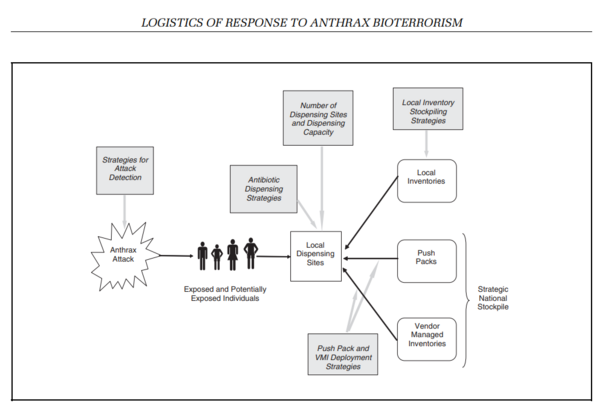Smallpox and Anthrax as Agents of Bioterrorism
Introduction to Bioterrorism

By Emily Rogers
Bioterrorism is defined as using “using biological agents to inflict disease and/ or death on humans, animals or plants, and motivations for pursuing such an attack could have religious, political, or criminal motivations.”[1] People that plan and perform bioterrorism attacks could also be a part of nationalist, separatist, or apocalyptic cult groups.[2] Biological agents can also be used by military and government agencies in warfare.[2] Early records of bioterrorism in the 14th century include the Tartar group attacking the city Kaffa by catapulting cadavers infected with the plague, caused by the bacteria Yersinia pestis, over the walls of the city, causing the plague to spread over the Mediterranean.[2] More recently in 1984, a cult following the Rajneeshee movement poisoned a restaurant in Oregon with Salmonella bacteria because they had political motives to win an election.[2] Unlike other types of terror attacks, bioterrorism has the unique ability to go undetected for a severe length of time, in which infected individuals can spread the agent even further, before the attack event is even detected.[2]Starting in 2001 and last reviewed in 2018, the Centers for Disease Control and Prevention (CDC) has published a list of the most dangerous infectious agents that could be used for bioterrorism acts.[3] Anyone born after the 1970’s will not have been vaccinated because most countries stopped providing the vaccine after the virus was eradicated.[4]
The insertion code consists of:
Double brackets: [[
Filename: PHIL_1181_lores.jpg
Thumbnail status: |thumb|
Pixel size: |300px|
Placement on page: |right|
Legend/credit: Electron micrograph of the Ebola Zaire virus. This was the first photo ever taken of the virus, on 10/13/1976. By Dr. F.A. Murphy, now at U.C. Davis, then at the CDC. Every image requires a link to the source.
Closed double brackets: ]]
Other examples:
Bold
Italic
Subscript: H2O
Superscript: Fe3+
Sample citations: [5]
[6]
A citation code consists of a hyperlinked reference within "ref" begin and end codes.
To repeat the citation for other statements, the reference needs to have a names: "Cite error: Closing </ref> missing for <ref> tag Symptoms of smallpox include fever and the characteristic skin rash of pox, and it has a 30% mortality rate. The mortality rate of smallpox for pregnant females was very high, up to 70% for those unvaccinated. Ocular variola and resulting blindness was common in smallpox patients in Asia. Smallpox in children caused elbow and knee joint problems in around 2% of unvaccinated children. Those who survived having smallpox were left with many scars on their body.
Smallpox

Variola major is the virus that causes smallpox.[7] Symptoms of smallpox include fever and the characteristic skin rash of pox, and it has a 30% mortality rate.[7] The mortality rate of smallpox for pregnant females was very high, up to 70% for those unvaccinated.[7] Ocular variola and resulting blindness was common in smallpox patients in Asia.[7] Smallpox in children caused elbow and knee joint problems in around 2% of unvaccinated children.[7] Those who survived having smallpox were left with many scars on their body.[7] Variola virus emerged thousands of years ago and has subsequently infected many human populations throughout history, causing epidemics of smallpox.[7] The oldest description of smallpox came from China in the 4th century CE. Remnants of smallpox pustules have been found on Egyptian mummies that were 3,000 years old.[7] It is theorized that trade and exploration contributed to the spread of smallpox.[7] Variolation was an early method for control
Section 3
Include some current research, with at least one figure showing data.
Section 4
Conclusion
References
- ↑ Klietmann, W., & Ruoff, K. (2001). Bioterrorism: Implications for the Clinical Microbiologist. Clinical Microbiology Reviews, 14(2).
- ↑ 2.0 2.1 2.2 2.3 2.4 Poupard J. A. and Miller L. A. History of biological warfare: catapults to capsomeres. Ann. N.Y. Acad. Sci. 666 1992 9 -20
- ↑ Bioterrorism agents/ diseases. (2018, April 4). Centers for Disease Control and Prevention. Retrieved April 14, 2023, from https://emergency.cdc.gov/agent/agentlist-category.asp#catdef
- ↑ Cohen, J. (2001). Smallpox Vaccinations: How Much Protection Remains? American Association for the Advancement of Science, 294(5544).
- ↑ Hodgkin, J. and Partridge, F.A. "Caenorhabditis elegans meets microsporidia: the nematode killers from Paris." 2008. PLoS Biology 6:2634-2637.
- ↑ Bartlett et al.: Oncolytic viruses as therapeutic cancer vaccines. Molecular Cancer 2013 12:103.
- ↑ 7.0 7.1 7.2 7.3 7.4 7.5 7.6 7.7 7.8 History of smallpox. (2017, July 12). Centers for Disease Control and Prevention. Retrieved April 15, 2023, from https://www.cdc.gov/smallpox/history/history.html
Authored for BIOL 238 Microbiology, taught by Joan Slonczewski, 2023, Kenyon College
